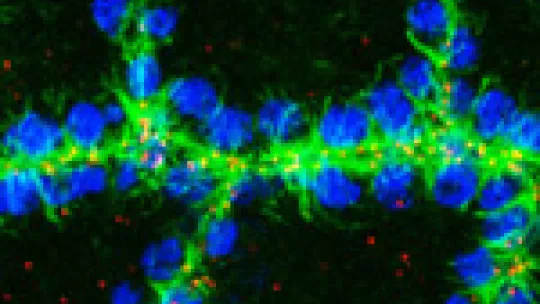Images
A group of researchers discover a mechanism based on two proteins that regulate the microtubule network formation in embryonic cells.
Microtubules are like internal cellular transport networks and are fundamental for processes such as the secretion of substances, and cell movement and morphology.
A group of researchers at the “Instituto de Biología Molecular de Barcelona”, part of the Spanish National Research Council (acronym CSIC in Spanish), at the Institute for Research in Biomedicine (IRB Barcelona) and the Jacques Monod Institute of the CNRS (France) have made new findings that would explain how the development of the microtubule network inside embryonic cells is regulated. The study has just been published in the last issue of the journal Developmental Cell, part of the Cell group.
Microtubules are structures that act as transport pathways for products inside cells. Many important functions such as the secretion of substances, and cell movement and morphology depend on these structures in many cells types. Thus, the secretion of hormones of cells that form part of the endocrine and digestive systems depend on these microtubules. In the case of a neuron, the organisation of the microtubule network inside axons allows substances to be transported between connections along which nerve signals are transmitted. The final role of cells or their morphologies depend on how this network of microtubules is organised. However, little is known about the mechanism that controls this organisation.
The study performed by the researchers reveals the mechanism that operates during cell specialisation. Jordi Casanova, CSIC research professor at the “Instituto de Biología Molecular de Barcelona” and IRB Barcelona, explains that in this process the protein Spastin cuts the microtubules from their previous anchor site and another protein, Pio, anchors them to a new site. After this operation, the microtubules are organised from this new point and direct transport inside the cells to this new site.
The research has been performed in embryos of the fruit fly, Drosophila melanogaster, and the results, comments Jordi Casanova, shed Light on how cells differentiate to become specialised. Although the Drosophila model has been used here, the researchers believe that this mechanism could be common to all vertebrates.
Mercè Fernández
About IRB Barcelona
The Institute for Research in Biomedicine (IRB Barcelona) pursues a society free of disease. To this end, it conducts multidisciplinary research of excellence to cure cancer and other diseases linked to ageing. It establishes technology transfer agreements with the pharmaceutical industry and major hospitals to bring research results closer to society, and organises a range of science outreach activities to engage the public in an open dialogue. IRB Barcelona is an international centre that hosts 400 researchers and more than 30 nationalities. Recognised as a Severo Ochoa Centre of Excellence since 2011, IRB Barcelona is a CERCA centre and member of the Barcelona Institute of Science and Technology (BIST).





